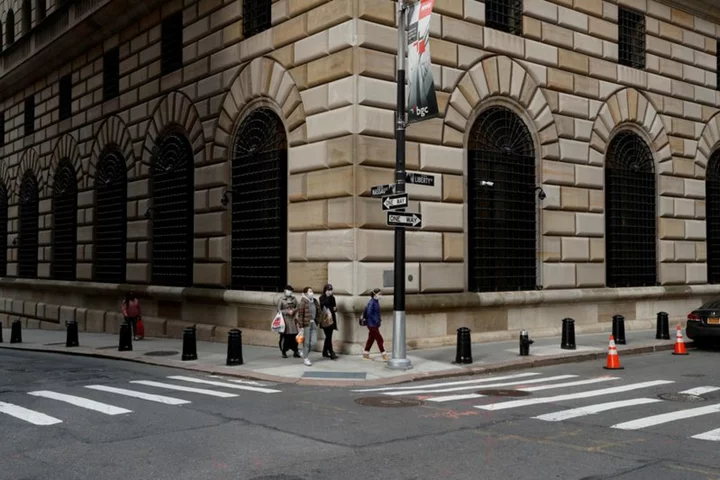By Harry Robertson
LONDON Bond traders are eyeing a return to a type of trade that left them battered earlier this year - betting on yield curves returning to a more normal shape as slowing economies force central banks to cut interest rates.
The shape of the yield curve has been in the spotlight over the last week, with U.S. and European 10-year bond yields rising sharply compared to their shorter-dated peers.
Those moves have put the focus back on "steepening trades" - bets that shorter-dated yields will fall relative to longer-dated yields. Many investors say the big rush into such wagers will come when central banks look poised to cut interest rates to bolster growth.
In these trades, investors buy a short-dated bond in the hope that its price will rise and the yield will fall, and short - that is, bet against - a longer-dated bond for the opposite reason. They are likely to use futures contracts, which make it easier to bet on the direction of assets.
"Everyone is now re-looking at these curve trades," said Olivier De Larouziere, chief investment officer for global fixed income at BNP Paribas Asset Management.
The renewed interest comes as the U.S. Federal Reserve and European Central Bank get close to the end of their aggressive rate-hiking cycles, potentially bringing two years of bond-market suffering to a close.
"It's a typical end-of-cycle trade," said Fabio Bassi, head of international rates strategy at JPMorgan. "I would expect that in the next quarter, more people will start positioning for a steepening of the yield curve."
A PAIN TRADE
Central banks' rate hikes have pushed up yields on short-dated bonds, which are highly sensitive to short-term borrowing costs. Longer-dated yields have risen less sharply, because investors expect rates to fall at some point in the future.
That's led to a rare situation where the bond yield curve is "inverted".
Many investors thought the situation was untenable at the start of 2023 and that shorter-dated yields would drop as central banks paused rate hikes, or even started cutting in response to a slowdown in growth.
Those bets turned out to be wrong. The gap between two- and 10-year U.S. Treasury yields, for example, hit its deepest inversion since 1981 at the start of July at around -110 basis points, as inflation remained stubborn and investors braced for more rate hikes.
"The steepening trade has been very painful for a lot of investors," said Alexandre Caminade, chief investment officer for core fixed income at asset manager Ostrum.
DIPPING A TOE BACK IN
Some investors are creeping back into steepening trades in longer-duration bonds, betting that 30-year bond yields will rise relative to 10-year yields.
"We have already started to switch, some months ago, from flattening to steepening in Europe, mainly at the long end of the curve," said Anne Beaudu, global fixed income portfolio manager at Amundi, who said she is betting on a steepening of the 10-year-to-30-year section of the yield curve.
"As long as the ECB stays hawkish and continues to hike rates, it's a bit too soon to have a steepener at the very short end of the curve."
De Larouziere of BNP Paribas also said he has positioned for a 10-year-30-year steepening. JPMorgan's Bassi said the longer-end of the curve tends to steepen first as growth slows - weighing on 10-year yields relative to the more independent 30-year yields - but policy rates remain high for a period, keeping shorter-dated yields steady.
TIMING IS EVERYTHING
The market moves over the last week highlight the risk of curve trades. Few investors expected longer-dated yields to start rising faster than shorter-dated yields, in what's known as a "bear steepening".
Analysts said a key factor in the move is a growing belief that the U.S. economy might avoid any serious downturn. That could complicate bets on a "bull steepening" - where shorter-dated yields drop as interest rates fall.
"We have to be a bit humble here, and cautious," said Franck Dixmier, chief investment officer for fixed income at Allianz Global Investors.
Dixmier and other investors stressed that timing was key and getting it wrong could be painful. "That is a winning trade, potentially to implement in 2024, or maybe a bit earlier. It's clearly linked to the evolution of core inflation," he said.
Those keen on steepeners may have found some solace in comments from New York Fed chief John Williams, who said in a New York Times interview published on Monday that he did not rule out the possibility of lowering rates in early 2024, adding that inflation was coming down as hoped.
Ostrum's Caminade said: "When we will be sure that central banks will reach terminal rates, and we have a better view on the cuts next year, I think it will be a moment to put the steepeners in the portfolio.
"At the moment we think that it's too early. But it will be the next big, big trade."
(Reporting by Harry Robertson; Editing by Sharon Singleton)

